#professor shonku
Explore tagged Tumblr posts
Text
BEST DIRECTORS IN CINEMA-3
Hi everyone! This blog is going to be the 3rd part of 8 Part Series of who I think are the Best Directors Cinema as ever seen
And today I will be talking about
SATYAJIT RAY
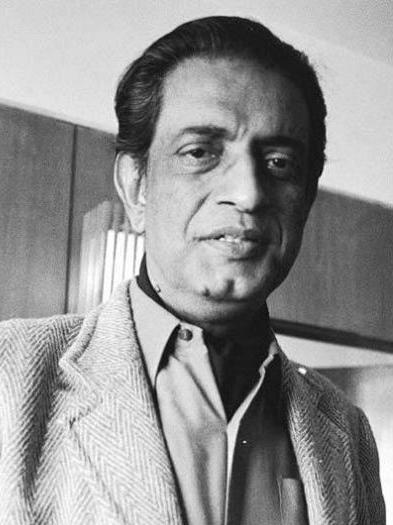
Satyajit Ray (born May 2, 1921, Calcutta [now Kolkata], India—died April 23, 1992, Calcutta) was a Bengali motion-picture director, writer, and illustrator who brought the Indian cinema to world recognition with Pather Panchali (1955; The Song of the Road) and its two sequels, known as the Apu Trilogy. As a director, Ray was noted for his humanism, his versatility, and his detailed control over his films and their music. He was one of the greatest filmmakers of the 20th century.
(Early Life)
Ray was an only child whose father died in 1923. His grandfather was a writer and illustrator, and his father, Sukumar Ray, was a writer and illustrator of Bengali nonsense verse. Ray grew up in Calcutta (now Kolkata) and was looked after by his mother. He entered a government school, where he was taught chiefly in Bengali, and then studied at Presidency College, Calcutta’s leading college, where he was taught in English. By the time he graduated in 1940, he was fluent in both languages. In 1940 his mother persuaded him to attend art school at Santiniketan, Rabindranath Tagore’s rural university northwest of Calcutta. There Ray, whose interests had been exclusively urban and Western-oriented, was exposed to Indian and other Eastern art and gained a deeper appreciation of both Eastern and Western culture, a harmonious combination that is evident in his films.
(His Famous Works)
Ray's first film, Pather Panchali (1955) won eleven international prizes, including the inaugural Best Human Document award at the 1956 Cannes Film Festival. This film, along with Aparajito (1956) and Apur Sansar (The World of Apu) (1959), form The Apu Trilogy. Ray did the scripting, casting, scoring, and editing, and designed his own credit titles and publicity material. He also authored several short stories and novels, primarily for young children and teenagers. Popular characters created by Ray include Feluda the sleuth, Professor Shonku the scientist, Tarini Khuro the storyteller, and Lalmohan Ganguly the novelist.
(Filmmaking Style)
His Filmmaking
Ray had been subconsciously paying a tribute to Jean Renoir throughout his career, who influenced him the most.Ray considered script-writing to be an integral part of direction. Initially he refused to make a film in any language other than Bengali. In his two non-Bengali feature films, he wrote the script in English; translators adapted it into Hindustani under Ray's supervision.The narrative structure of Ray's films are represented by musical forms such as sonata, fugue and rondo. Kanchenjunga, Nayak and Aranyer Din Ratri are examples of this structure.
(His Filmography)
Ray made over 36 feature film in his 4 decade long. He made movies such as Pather Panchali in 1955,Aparajito in 1956,Parash Pathar and Jalsaghar in 1958, Apur Sansar in 1959, Devi in 1960. He made movies such as Teen Kanya in 1961, Kanchenjungha and Abhijan in 1962,Mahanagar in 1963,Charulata and Two I'm 1964,Kapurush-0-Mahapurush in 1965,Nayak in 1966,Chiriyakhana in 1967,Goopy Gyne & Bagha Byne in 1969,Aranyer Din Ratri and Pratiwandi in 1970, Seemabaddha and Sikkim in 1971,Inner Eyes in 1972,Ashani Sanket in 1973,Sonar Kella in 1974,Jana Aranyw in 1975,Bala in 1976,Shatranj ka Khilari in 1977,Joi Baba Felunath in 1979,Hirak Rajar Deshe and Pikoo in 1980,Sadgati in 1981,Ghare Bhare in 1984,Sukumar Ray in 1987,Ganashatru and Shakha Proshakha in 1990,Agantuk in 1990.
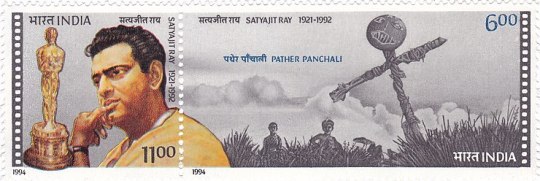
Satyajit Ray on 1994 stamp of India
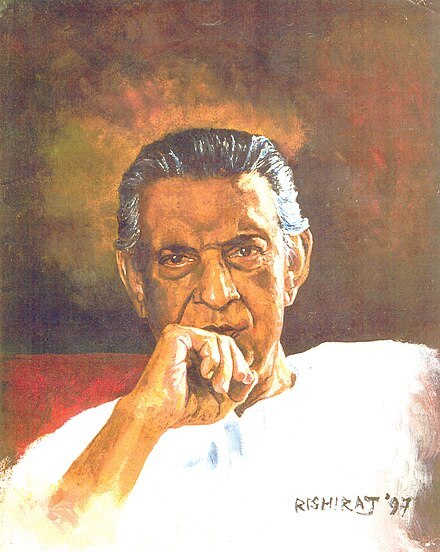
Portrait of Satyajit Ray
(Awards & Honors)
Ray received many awards including 36 National Film Awards. He was awarded the Dadasaheb Phalke Award in 1985 and Legion Of Honor in 1987. The Government of India also awarded him with Padma Bhusan in 1965. He also received a Lifetime Achievement Award in 1992 at the Academy of Motion Pictures Arts and Sciences. He also won the Golden Lion at the Venice Film Festival
(Legacy)
Ray is considered one of the greatest film directors of all time. He is a cultural icon in India and in Bengali communities worldwide. Following his death, the city of Calcutta came to a virtual standstill, as hundreds of thousands of people gathered around his house to pay their last respects. Ray's influence has been widespread and deep in Bengali cinema; many Bengali directors, including Aparna Sen, Rituparno Ghosh and Gautam Ghose as well as Vishal Bhardwaj, Dibakar Banerjee, Shyam Benegal and Sujoy Ghosh from Hindi cinema in India, Tareq Masud and Tanvir Mokammel in Bangladesh, and Aneel Ahmad in England, have been influenced by his craft.Beyond India, filmmakers Martin Scorsese, Francis Ford Coppola, George Lucas, James Ivory, Abbas Kiarostami, Elia Kazan, William Wyler,François Truffaut, John Huston, Carlos Saura, Isao Takahata, Oliver Stone,Quentin Tarantino, Wes Anderson,Danny Boyle and Christopher Nolan.
(Sources)
And that's it for this part folks, I'll meet you with another blog about some the Greatest Directors Cinema has ever seen, Until then
CIAO
3 notes
·
View notes
Text
Assistir Filme The Shonku Diaries: A Unicorn Adventure Online fácil
Assistir Filme The Shonku Diaries: A Unicorn Adventure Online Fácil é só aqui: https://filmesonlinefacil.com/filme/the-shonku-diaries-a-unicorn-adventure/
The Shonku Diaries: A Unicorn Adventure - Filmes Online Fácil

Nesta aventura familiar, um irmão e uma irmã, Mo e Melody, junte-se ao brilhante cientista e professor de inventor Shonku e seu robô Ajudante Robu para encontrar o seu lendário de explorador perdido. Logo eles se encontram no fundo do Himalaia, seguidos pelo mal Franzotti que está rastreando um tesouro escondido. Ao longo do caminho eles encontram unicórnios e outras criaturas mágicas, e descobrem um paraíso oculto mantido longe do mundo.
0 notes
Text
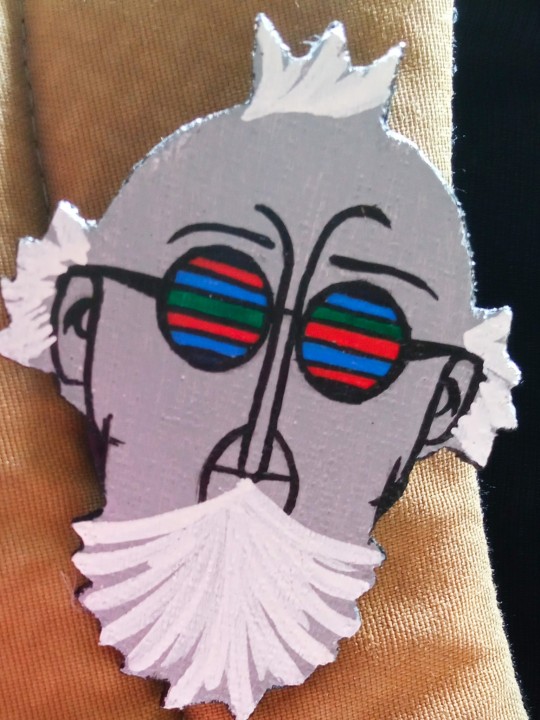
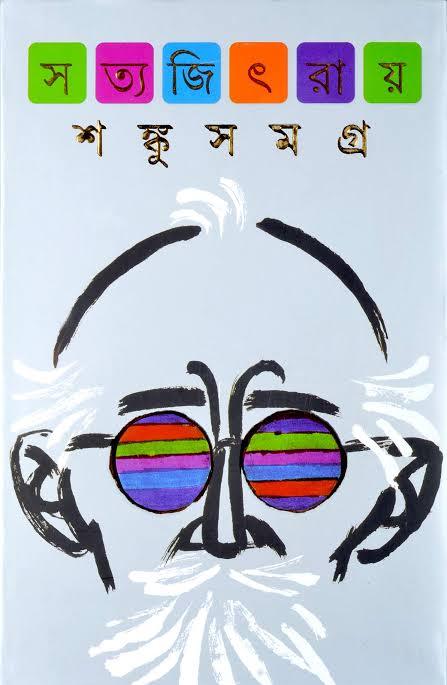
look at my professor shonku brooch! bought it at a college stall today ♥💜💛💚💙
professor shonku is a character by satyajit ray, made popular in his sci fi series of the same name. he is an eccentric scientist who lives with his cat, named newton. his stories are written in the form of diary entries and range from funny to downright macabre and I cannot recommend them enough.
#personal#professor shonku#sci fi#scifi#satyajit ray#bengali#bengali literature#indian literature#india#desi#desiblr#books
52 notes
·
View notes
Photo







Professor Shonku + The Onion headlines
#when i say bengali fandoms need content this is what i mean#i think these are neat might make more later#professor shonku#bangla tag#bengali literature#bengblr#is that a thing yet#shitpost#meme#edit#The Onion#the onion headlines#peevesie makes things#original content#bengali#satyajit ray
131 notes
·
View notes
Photo

Prof. Shonku forced to relive the anti-Semitic hooligan
By Satyajit Ray(সত্যজিৎ রায়)
Illustration for the story Professor Shonku and Frankenstein(প্রফেসর শঙ্কু ও ফ��রাঙ্কেনস্টাইন)
13 notes
·
View notes
Text

A very random crow. I really don't know why I think that it's relevant enough to post. But this is a good gentle crow who comes to our terrace to drink water.
#why do I suddenly get the urge to post these#i'll call this crow here korvus as a tribute to professor shonku#and well crows are called corvus....#miru rambles
3 notes
·
View notes
Text
We don't really write science fiction for kids do we? Maybe some dystopian YA fiction. Hmmm, or Artemis Fowl maybe?
Horror, fantasy, contemporary, detective fic, even historical fiction for children, I can think of fairly easily... the closest I can think of to children's sci fi is Professor Shonku
Am I missing something obvious?
13 notes
·
View notes
Note
heyyyyy congrats again!!! i'm really happy for you and you definitely deserve this!!!!!!
now for the celebrationnn
Briny Deep: my favorite book is Wilder Girls and I've been wanting to talk about it with someone for so longgggg but idk anyone who have read it so yeah that's my recommendation!!!
Thank you so much @moony-likes-hot-choc!! 😄
Join my 285 followers celebration here!
Yes, it's time for the celebration.
Briny Deep (meaning: The ocean): Give me a book/movie/song rec and I will give you one belonging to the same genre as the former.
Okay, so, I looked up the genre of 'Wilder Girls' on Google and I found it to be YA science fiction (dystopian) and first of all, let me tell you, bestie - THANK YOU SO MUCH!! 'Coz YK, my reading list has always been rather full of classics - I love classics but still, I have always wanted to expand it to other genres, especially YA. But then, whichever YA books I found on Amazon or in the book shops, they have always focused more on romance and the associated stuff. And as much of a fan of romance as I am, I do like reading stuff not centred on romance, at times. And from the summary I read on Google, this book seems to be the kind I was looking for! So, once again, thanks a lot, bestie! 😃
And, the books I'd like to recommend from the sci-fi genre are 'The Time Machine' by H.G. Wells and 'The Incredible Adventures of Professor Shonku' by Satyajit Ray (this was originally written in Bengali but an English translation is available).
Thank you for sending in the ask, bestie! 😊
4 notes
·
View notes
Text
Bengali Academia
Last time I made a compilation of some Indian Academia picks, most of which were works written in English. So I thought I'll put together a book rec list but this time the works are in Bengali as we have a very rich heritage and it's high time I promoted my own culture :) this list is subjective and contains entries compiled with the help of my family and friends. Please keep in mind that the Bengali literary canon is VAST and encompasses works from India and Bangladesh and I cannot possibly represent every single author I have ever read and loved.
Political:
Pather Dabi [transl: The Way of The Road] by Sarat Chandra Chattopadhyay: revolutionary secret society in colonial india!! an actually likeable hero!! splendid anti establishment bengali youths!! themes like untouchability, decolonisation and female empowerment!! I will rec this book until my absolute dying breathe, especially because the whites™ banned it.
Ghare Baire [transl: The Home and the World] by Rabindranath Tagore: explores complex paradoxes in the early phase of the national independence movement, like western "progressive" theory vs western imperialism, patriotism vs aggressive nationalism, and the double alienation of desi women by Britishers + their own society. raises very pertinent questions about forceful "emancipation" of women, very layered characters and gorgeous prose.
Char Adhyay [transl: Four Chapters] by Rabindranath Tagore: you can read this as either the star-crossed love story of revolutionaries Ela and Atin, or a scathing critique of militant nationalism, embodied by the brilliant, ruthless, manipulative rebel leader Indranath. or both. either way, a great portrayal of systematic brainwashing by extremist groups, though does get a tad bit angsty at times.
Kaalbela [transl: Doomsday] by Samaresh Majumdar: you know the drill. Naxalite movement. Bengal burning. Love in the times of communism and revolution and police raids. Fun stuff. If you loved Udayan and Gauri from The Lowland pls read this.
Hajar Churashir Maa [transl: 1084's Mother] by Mahasweta Devi: a harrowing exploration of 70s Naxalite Bengal, state brutality, and the cost of resistance as seen through the eyes of Sujata, a mother battling to piece together the events leading to the murder of her son, rebel Brati. this one is particularly devastating and can be triggering in the current political climate. but god, what a read.
Social:
Pather Panchali [transl: Song of the Road] by Bibhutibhushan Bandopadhyay: if you haven't read the book, you have probably heard of the equally gorgeous movie. It's about a village on the far precincts of rural Bengal, it's about a brother and a sister and a family whose destinies keep pulling them apart and together, and it's about other things too, a field after a rainstorm, fresh mangoes, the gnaw of hunger and the kind of love that suffers.
Padma Nadir Majhi [transl: The Boatman on the River Padma] by Manik Bandopadhyay: an epistolary story about the lives of the impoverished fishermen community living in the Padma delta strip in Bangladesh, and a man ferrying relocated settlers to a utopian riverine island named Moynadip. The river acts almost as a sentient presence through this novel about class conflicts. I remember reading this in middle school, the prose is to die for. Also, Kuber, the main character is v.v. good I kind of love him.
Satyabati trilogy by Ashapurna Debi: *slams hands on table* INTERGENERATIONAL FEMALE RAGE!! mother and daughter and granddaughter battling the same oppressive fate!!! Feminist and anti brahmanical academia!! Women writing about women!!
Chokher Bali [transl: Eyesore] by Rabindranath Tagore: it's about two women- beautiful briliant widow Binodini and her sweet naive friend asha, and the way their stories spill into each other. sometimes privileged men write surprisingly good stories about women who are flawed, women who want things, women with ambition and love and tenderness and lust and regret and jealousy.
Srikanto by Sarat Chandra Chattopadhyay (#1): bisexual himbo spends entire adolescence pining after hot male best friend before growing up, doing drugs and getting reunited with a former flame who now works as a courtesan. Involved: a snake charmer, baggy pants, feverish dreams, ghosts on the river's edge, and this one line that keeps me awake all night and which I totally lost in translation: "sometimes the best kind of love bewitches. Other times, it simply dethrones you."
Devdas by Sarat Chandra Chattopadhyay: or as I like to call it childhood sweethearts Dev and Paro battles The Bengali Class Hierarchy and Third Degree Alcoholism while the courtesan Chandramukhi is busy being an unproblematic angel whom I love :) also pls don't watch the film it is kind of cringe idk
Aranyak [transl: Of the Forest] by Bibhutibhushan Bandopadhyay: read the memo it's about forests. it's about a man enamoured by forests and it's about people whose lives are inextricably bound to the trees, for better and for worse. actually pretty sad, but the journey through that sadness is lovely.
Non fiction
Pakdondi by Leela Majumdar: whimsical, gentle memoir/travelogue about the author's childhood in Shillong and Calcutta. Think hill stations and winter flowers and soft sunshine. Has the wistful nostalgia of a Ghibli film. I love her writing sm.
Any work by Nabaneeta Deb Sen, particularly Truck Bahone McMahon [transl: On a Truck Alone to McMahon], which details her road trip to the North East Indian states in the humorous precision only she can bring. Her writing style blends factual and funny in the same vein as Ruskin Bond and I had a good time with this.
Deshe Bideshe [transl: In a Land Far from Home] by Syed Mujtaba Ali: an account of the author's two year stay in Kabul between 1927-29 when the country was going through sweeping reforms under the controversial reign of King Amanullah. It's a little glimpse into a system and a time not often documented in literature, and Ali's writing is a gem. you'll enjoy this is you enjoy Ruskin Bond and William Dalrymple.
Mythology/Retellings
Rajkahini [transl: Stories of Kings] by Abanindranath Tagore: another favourite, lyrical, descriptive, half magical half historical goodness, this collection of short stories centres around ancient Rajput dynasty folklore and mythical histories. The accompanying illustrations are equally beautiful.
Tagore's Nritya Natya (dance drama) series of plays which centre around folklore. Think royal intrigue, warrior princesses falling in love with gods and the plight of benevolent monks and "untouchable girls". I adore nritya natya because most bengali girls learn these plays and the leitmotif songs and stories growing up.
Shei Shomoye [transl: Those Days] by Sunil Gangopadhyay: written in Sunil's typical wistful lilt, it is a retelling of the life of Bengali satirist and playwright Hutum Pacha (aka kaliprasanna sinha) as well as several historical figures like Michael Madhusudan, Tagore etc. Recommended by my mutuals and followers alike.
Tungabhadrar Tire [transl: By the Tungabhadra] by Sharadindu Bandyopadhyay: a fleet carries two princesses to vijaynagar where one of them is to wed the king as part of a political alliance. but of course things fall apart (as they always do) and you get a whole cocktail of torrid affairs and 14th century politics albeit the joy is tempered considerably by the author's very Quirky Misogyny and a certain degree of SLB-esque Islamophobia ://
Poetry
Shakti Chattopadhyay (themes: restlessness, nature, modernism, translated verses)
Kalyani Thakur Charal (social commentary, dalit representation, feminism)
Rabindranath Tagore (mysticism, pastoralism, time)
Jibanananda Das (speculative, modernism, existentialism)
Michael Madhusudan Dutta (epic poetry, nature, sonnets)
Kazi Nazrul Islam (patriotic, anti colonial, social commentary......an icon ahead of his time.....king™)
Self indulgent recs
Abol Tabol by Sukumar Ray is one of those priceless books of nonsense/satire poetry rendered second grade in translation, I'm afraid. If you can, read the Bengali version. In fact, read any of Sukumar Ray's works, it's like taking an acid trip with Hayao Miyazaki and Louis Caroll, icon really created That Rich A Bibliography™ in his unfairly short life :') it's funny, it's unsettling, it's ridiculous, it's savage.
Professor Shonku series by Satyajit Ray: this sci-fi/thriller collection is written in the format of a long-lost journal, detailing the colourful and sometimes genuinely creepy adventures of whimsical old scientist Trilokeshwar Shonku. The professor is aided on his trips by faithful and benevolently dumb attendant Prohlad and his cat Newton. This series is so ridiculous and inventive and good, Ray's writing is so readable and the accompanying illustrations are charming AF. A nostalgic fave.
Feluda series by Satyajit Ray: you've partaken of bengali culture, you have studied museums and archives and watched documentaries. But did you read feluda? No? Not a very successful cultural integration then, was it?
Podi Pishir Bormi Baksho (transl: The Burmese Box of Aunt Podi) by Leela Majumdar: one eventful night, the Burmese treasure chest of a formidable bengali matriarch is stolen, spawning generations of hatred, bloodshed and betrayal. PEAK comedy gold. every time I reread this book it leaves me in hysterics.
Byomkesh series by Sharadindu Bandyopadhyay: rounding off this list with my favourite dark academia detective boy, byomkesh is very well written and very likeable and very aesthetiqué if you are looking for crimes and felony and the seven deadly sins in the heart of colonial and post-partition calcutta. if you like Poirot, you will love this series, particularly the earlier stories.
This list is definitely not comprehensive! For logistical purposes, I was unable to add Tagore's entire Body of Work©, or ALL of Nazrul's poems....else we'd be here a few days. There are many, many names and titles missing. My list is limited by my own reading experience and the books I know from recommendations. However, I just wanted to make this list for a long time as I rarely see Bengali literature hyped on tumblr. Feel free to add more!
#mimiwrites#dark academia#poc dark academia#chaotic academia#light academia#dark academia aesthetic#india#indian literature#indian aesthetic#classic literature#studyblr#writeblr#books#book recs#classics#poc academia#poc#literature#history#poetry#bengali#kolkata#long post //
791 notes
·
View notes
Text
I Do Not Like when adaptations modernize 20th century bengali stories because those stories are tied to the time they're set in and don't make sense in modern settings and because they're rarely adapted well. BUT (and read that "but" in Pepa's voice) I am a very strong believer of "fandoms should have more freedom than adaptations because adaptations have a legitimacy that fandom is not bound to".
Is gen z tenida legit enough to actually Be in an adaptation? No. Is it a very funny concept regardless? You bet
#this doesn't mean I'm actually going to make modern aus I'm just thinking out loud#let pyala be a tumblr girlblogger 2k22#he'd put writer in his bio and not write anything except shitposts#topshe has a feluda stan blog. they're mutuals#kyabla has facebook and twitter only for lurking and observing drama#professor shonku met sanders and kroll on the internet#and kroll posted selfies with ''met the mutuals xoxo'' when they met#jatayu is somehow in many fb groups and forwards ''fun fact'' posts (some of which are fake) to feluda and topshe#he also has a page for bhodrotar khatir but doesn't really use it#oh and!! chaotic charmurti gc#everyone is group admin and they keep changing the icon multiple times a day because they can't agree on one selfie#and ruku's black themed multifandom rp blog ofc#anyway#shitpost#bangla tag#bengblr#feluda#tenida#professor shonku#peevesie speaks#gen z tenida
38 notes
·
View notes
Text
Here's a list of things I need:
1. Money, a whole lot of it.
2. My own apartment.
3. A very warm and tight hug (preferably a very long one too)
4. A rich husband
5. Someone who I can hold hands with
6. A best friend I can hang out with, like IRL...
7. A 6 month long vacation
8. My own laptop
9. Idk if anyone will get this reference, but I need those Miracureall tablets from Professor Shonku books
10. The chance to sleep in while it's raining outside
2 notes
·
View notes
Note
I'm very curious...have you read Feluda ??
Haaan ! I love the series ! But I like professor Shonku better 😁
3 notes
·
View notes
Photo

Prof. Shonku’s Spaceship travelling admist stars, moons and asteroids
By Satyajit Ray(সত্যজিৎ রায়)
Illustration for the short story The Diary of a Space Traveller (ব্যোমযাত্রীর ডায়রি)
11 notes
·
View notes
Text
Remembering The Journey Of Satyajit Ray on his 100th Birth Anniversary
Whenever we are discussing about Indian Cinema that would be incomplete without mentioning Satyajit Ray.
One Of India’s finest Film maker Dadasaheb Phalke Award Winning Legendary Film Maker Satyajit Ray was born in 2nd May, 1921 in Kolkata. Mr. Ray was an Film Maker, Writer, Illustrator, Calligrapher and most importantly a Visualizer who brought the Indian cinema to world recognition with Pather Panchali (1955, The Song of the Road) and its two sequels, known as the Apu Trilogy.
Films created by Mr. Ray were way a head of his times in terms of Representation as he used to create magic with minimal Resources.
Truly As a director, Mr. Ray was noted for his versatility, and his detailed control over his films and their music.
Mr. Ray's Ability to stand out and evoke a certain emotion and his ever green golden films that will always be remembered by us.
Satyajit Ray grew up in Kolkata and was looked after by his mother Mrs. Suprabha Ray because his father Mr. Sukumar Ray was died when Satyajit was only 3 years old.
Ray completed his schooling from Ballygunge Government High School in Calcutta(Now Kolkata), and completed his BA in economics from Presidency College, Calcutta (then affiliated with the University of Calcutta), though his interest was always in the fine arts.
In 1940 his mother persuaded him to attend art school at Santiniketan, Rabindranath Tagore’s rural university northwest of Calcutta.
Returning back to Kolkata, Ray started working at British Owned Advertising Agency as a junior visualiser, then he became art director within few years.
As a graphic artist It was Ray who designed the covers of such books as Aam Aatir Bhepu (a children’s edition of Bibhuti Bhusan Banerjee’s Pather Panchali), Man-Eaters of Kumaon (Kumaom-er Manuskheko Bagh, in Bengali translation) by Jim Corbett and The Discovery of India by Jawahar Lal Nehru.
Ray was unable to curate money from Bengali Producers who represents such unconventional ideas in front of them. Then late 1952, using Ray’s own money, with the rest eventually coming from a grudging West Bengal Government, Ray and his determined crew came out with one of the most successful and ever green motion picture Pather Panchali which was completed in the year 1955.
Pather Panchali is the first part of Apu Trilogy and trilogy bestowed Ray with awards at Cannes, Venice and London.
Aparajito (The Unvanquished) and Apur Sansar (The World of Apu) made up this trilogy successful that received phenomenal international acclaim and was received globally as the trilogy.
As a writer Mr. Ray became so much popular among children by reviving children magazine “Sandesh”.
Writer Ray was come up with some evergreen detective & science fiction stories in Bengali Literature. By creating ever green Series Of Feluda, Satyajit Ray ensured that he gave children an occasion to celebrate their childhood.
Half a century after Ray’s fonts made their way to the typeface library, India has found itself on the forefront of The Typography Industry. With Lifelong accord with Type Face & Font, Ray came up with his most popular original font called “Ray Roman”.
At the same time, if we are talking about Satyajit Ray’s some of the Ever Green creations from his Golden Era then these names come first in mind, Devi (The Goddess), Teen Kanya, Kanchenjunga, Charulata, Professor Shonku, Nayak(The Hero), Sonar Kella and many more in the list.
It’s been 100 Glorious Years but still Ray remains in every Bengali’s Emotion.
Today We miss You Ray.......
1 note
·
View note
Note
It's good to see another Feluda and Professor Shonku fan after ages. Have a good day!
Yes!! I'm still reading some of the প্রফেসর শঙ্কু but I absolutely love it! And no words for ফেলুদা 😌
8 notes
·
View notes
Text
Price: [price_with_discount] (as of [price_update_date] - Details) [ad_1] 3 Rays is like exploring the Mother Earth, and finding the rare treasures'-Gulzar, poet, lyricist and film-maker'Satyajit Ray's work is like a beautiful scene from nature, and that's the reason we get lost in his beautiful art' -Shoojit Sircar, film-maker'Ray's magic, the simple poetry of his images and their emotional impact, will always stay with me'-Martin Scorsese, film director, producer, screenwriter and actor'Satyajit Ray's artifice and honesty set him apart from other film directors'-The Guardian'Satyajit Ray's world of restless watchfulness and nuance'-The New York Times'The quiet but deep observation . . . have impressed me greatly'-Akira Kurosawa, film-makerThe most anticipated book on the centenary birth anniversary of Satyajit RayAn amazingly brilliant collection of Satyajit Ray's previously unpublished autobiographical writings, illustrations, fictions and non-fictionsA collector's item, 3 Rays is a source of delight for every readerSatyajit Ray (1921-1992), through his life, philosophy and works offered a unique aesthetic sensibility, which took Indian cinema, art and literature to a new height. An ace designer, music composer, illustrator and a gifted writer, Ray gave us the awe-inspiring sleuth Feluda, and the maverick scientist, Professor Shonku-two iconic characters loved and revered by millions of readers. On the occasion of his centenary birth anniversary, 3 Rays: Stories from Satyajit Ray, the first book in The Penguin Ray Library series, opens a window to the brilliance of this Renaissance man. With more than forty stories and poems along with many unpublished works, autobiographical writings and illustrations by Ray, this volume offers a unique glimpse into Ray's creative genius. From the Publisher Publisher : Penguin (17 May 2021) Language : English Paperback : 478 pages ISBN-10 : 0143448986 ISBN-13 : 978-0143448983 Item Weight : 758 g Dimensions : 15.24 x 4.06 x 22.86 cm Country of Origin : India
0 notes